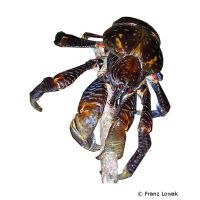Coconut Crab (Birgus latro)
| Coconut Crab Birgus latro | |
|---|---|
| Name | Coconut Crab |
| Name Lat. | Birgus latro |
| Family | Terrestrial Hermit Crabs |
| Family lat. | Coenobitidae |
| Order | Decapoda |
| Order lat. | Decapoda |
| Origin | Indo-West Pacific coastline |
| Habitat | Seashores |
| Diet | Fruits, veggies, insects, carrion |
| Humidity | 70-90 % |
| Behavior | Semi-aggressive |
| Keeping | Individual, group |
| Care Level | Experts only |
| Housing | Humid terrarium |
| Breeding | None reported |
| Life Span | 30-40 years |
| Protection | No |
| Metric Units | |
| Size | 35-40 cm |
| Temperature Day | 26-28 °C |
| Temperature Night | 20-25 °C |
| Housing Size | 2,0 x 1,5 x 1,5 m |
| US Units | |
| Size | 14"-16" |
| Temperature Day | 79-82 °F |
| Temperature Night | 68-77 °F |
| Housing Size | 80" x 60" x 60" |
Distribution and habitat
Palm thieves are widespread along the coasts of the tropical Indian Ocean and Western Pacific, except Indonesia and New Guinea. There they live on the beaches in caves, crevices and sand holes, which they usually leave only at night.
Maintenance
A terrarium of L 200 x W 150 x H 150 cm for an adult animal is recommended, which should be placed in a quiet and vibration-free place. For each additional animal, the floor space should be increased by 1 m².
They need thick, partly vertical branches and trunks for climbing as well as stone structures, cork bark, different sized snail shells and coconut shells, which serve as hiding places. The burrowable substrate of a sand-soil or sand-coconut fiber mixture must always be kept slightly moist and should be about twice the height of the animal to allow it to burrow and molt undisturbed. For water supply, a shallow dish with a climbing aid should be provided for both fresh and marine water. Several times a day the inside of the terrarium should be finely sprayed with water (humidity), but a rain or mist system is better
| Temp. day: 28 °C | Temp. night: 20-25 °C | Humidity: 70-90 |
Thermostatically controlled floor heating is recommended. The lighting duration should be 10-14 hours depending on the season. Daylight fluorescent tubes are ideal. A special UV lamp is not necessary.
Diet
They are omnivores and also consume carrion. The food offer consists of coconut meat, palm fruit, fruit (kiwi, mango, apple, pear, banana, melon, fig, etc.), insects, crustaceans (crabs, shrimp), snails, fish, vegetables (broccoli, zucchini, peppers, etc.) and much more, as well as dry food for dogs, cats and fish. Commercially available wet food for land hermit crabs can also be offered as a supplement. Depending on individual preferences, the composition varies. It is important to regularly add minerals (cuttlebone, calcium powder) and vitamins (dusting the food). Food should be offered in shallow bowls, sometimes elevated on thick branches. For drinking water they need both fresh and sea water. Unaccepted food should be removed after 4-5 hours.
Reproduction and breeding
Breeding has not yet been successful. Mating, usually from July to Augsut, takes place on land by the male turning the female on her back and passing a sperm packet. The male sexual orifices are on the hips (coxon) of the 5th running leg, the female on the hips of the 3rd running leg. The female deposits the eggs in the surf zone after about 1 month, at new moon, whereupon the larvae immediately hatch in the seawater. The larvae live planktonically in the seawater, go through several developmental stages in 3-4 weeks, and after another 3-4 weeks must have found a suitable shell to go ashore and perform the molt to juvenile crab. They reach sexual maturity at 5 cm carapace length after 4-12 years.
Important
During the day they usually burrow into the substrate. It is important that snail shells of different sizes or coconut shells are always available, because they also change the shell between molts. For molting they burrow in the sand for 2-6 weeks depending on their size and must not be disturbed under any circumstances. After molting, the carapace needs several days to harden. The old carapace is eaten and serves as a valuable source of minerals and should therefore not be removed.Group keeping is possible, but older males are often very dominant and must be isolated. Prior to purchase, knowledge of the biology and husbandry of the animal should be acquired and an appropriate terrarium prepared to meet the species specific needs. Good ventilation without drafts is necessary, as well as equipment for measuring temperature and humidity. The lighting must correspond to the species-specific day-night rhythm and must be placed in such a way that the animals cannot injure themselves. The terrarium should be locked in such a way that neither unauthorized persons can open it nor the animals can escape. Contamination must be removed regularly
Further literature can be found in your pet store.
References
Text: Evelyn Strizsik; Image: Franz Lowak
Source: ENGELMANN & LANGE (2011): Zootierhaltung - Tiere in menschlicher Obhut: Wirbellose, Harri Deutsch Verlag
